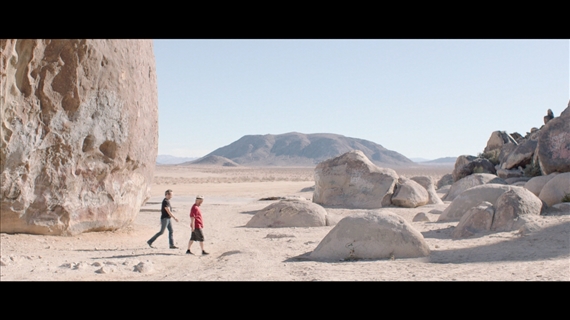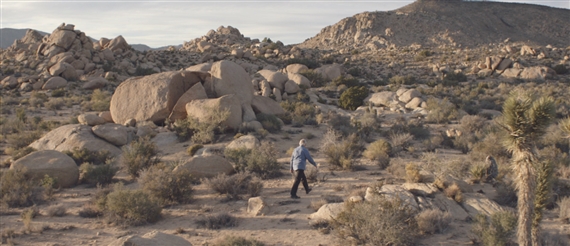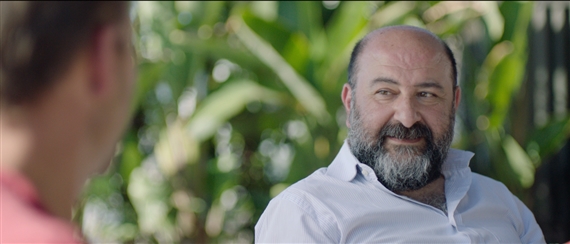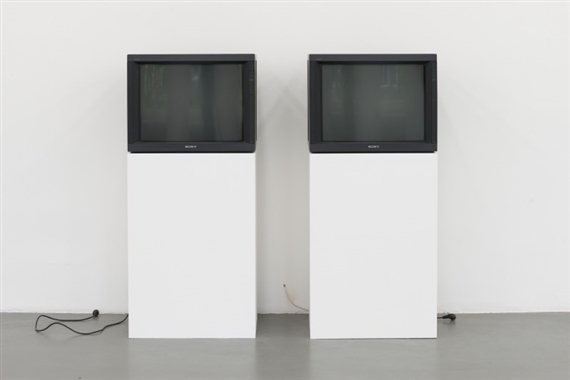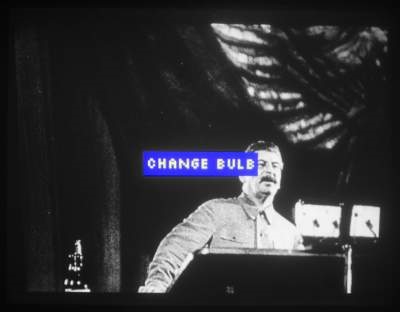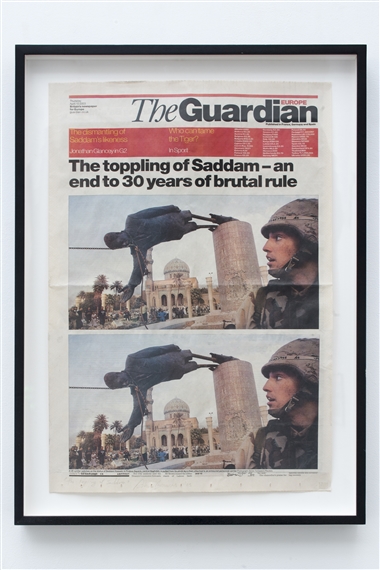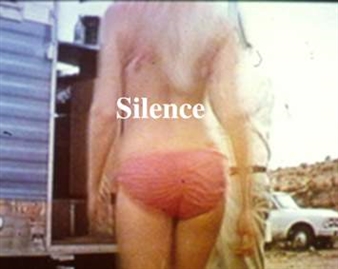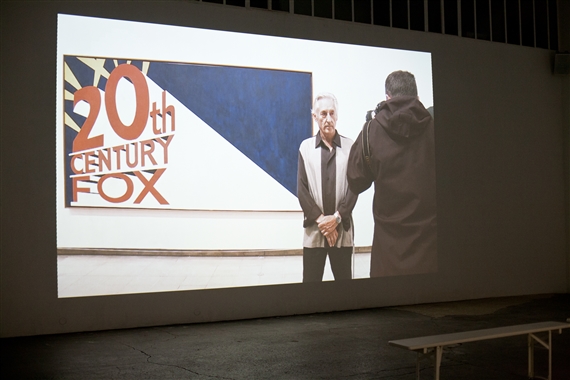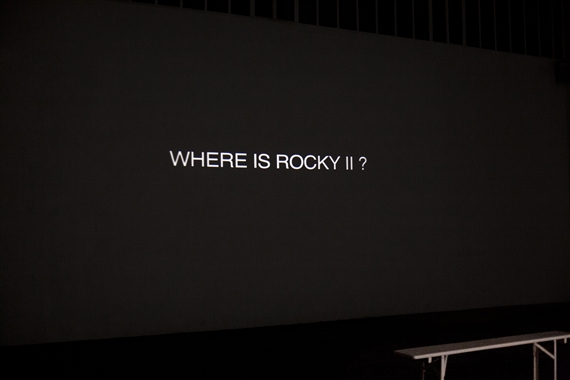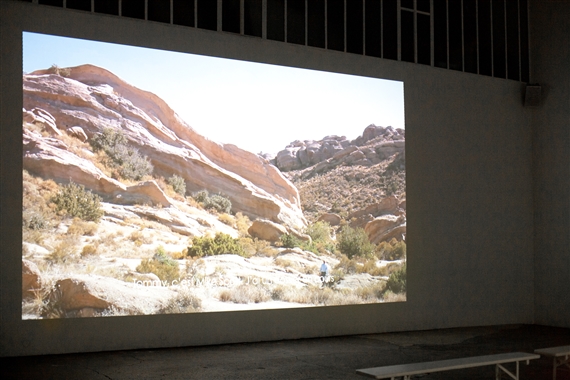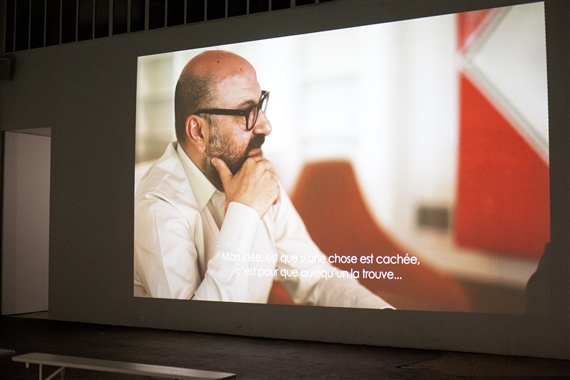Image may be NSFW. Pierre Bismuth, Where is Rocky II?, 2015. Courtesy of Where is Rocky II? film campaign. It all starts in 2009, when artist Pierre Bismuth attends a press conference for Ed Ruscha's retrospective Fifty Years of Painting at the Hayward Gallery in London, and asks Ruscha about the whereabouts of one of his works that had never been exhibited. A little surprised at the question, Ruscha, with a slight smile, simply replies, "So it's out there in the Mojave Desert somewhere. I'm not going to say where." Image may be NSFW. Pierre Bismuth, Where is Rocky II?, 2015. Courtesy of Where is Rocky II? film campaign. Maybe it all starts in 2006, when a friend gives Bismuth a copy of a 1980 documentary on Ed Ruscha filmed by Geoffrey Haydon for the BBC's Seven Artists Series. The 28-minute film draws parallels between Ruscha's work and the Los Angeles landscape, documents Ruscha crafting a fake boulder, and films him taking it out into the desert. Image may be NSFW. Pierre Bismuth, Where is Rocky II?, 2015. Courtesy of Where is Rocky II? film campaign. Or maybe it all starts in 1979, when Sylvester Stallone stars as the eponymous boxer in the sequel Rocky II. The same year, Ruscha, with help from his friend Jim Ganzer, make a large rock of resin and sand, titled Rocky II, which they then take out to an undisclosed location in the desert surrounding Los Angeles, planting it among all the extant boulders in the area. It looks just like all the rocks around it. Nothing is written about the piece, it is never exhibited, and the only record of it is the BBC documentary. Image may be NSFW. Pierre Bismuth, In prevention of technical malfunction - Unplugged Bruce Nauman video work, 2003. Courtesy of the artist and Witte de With Center for Contemporary Art, Photo: Cassander Eeftinck Schattenkerk. But maybe, it all actually starts in 2005, when Pierre Bismuth wins an Oscar for his original screenplay Eternal Sunshine of the Spotless Mind. As the Brussels-based artist recently told the Guardian, "With that thing in my hand, I realized it would be totally silly not to try to do something else in film, to capitalize on that success, because it was so unbelievable." And so began the hunt for Ruscha's rock. Image may be NSFW. Pierre Bismuth & Cory Arcangel, Untitled, 2008. Courtesy of the artists and Bugada & Cargnel, Paris. Bismuth ranks among the very few conceptual artists with Academy Awards. His work as a contemporary artist often utilizes other artists' works to serve as proxies by which he can destabilize our reading of cultural objects, drawing attention to constructs that we take for granted. This destabilization is effected by sometimes extremely simple gestures: for instance, his 2003 work To Prevent Technical Malfunctions (unplugged Bruce NAUMAN video) displays two blank, unplugged video monitors purportedly playing a Bruce Nauman video; a collaborative untitled video work with Cory Arcangel subverts Guy Debord's iconic 1973 film Society of the Spectacle by displaying the message indicating a weak projector lamp, "CHANGE BULB," over images from the film; in his "Newspaper" series, he doubles an image appearing on a newspaper cover, thereby introducing doubt as to the image's veracity. Above all, Bismuth is concerned with issues of perception and how we produce and consume culture. Image may be NSFW. Pierre Bismuth, The Toppling of Saddam (The Guardian - jeudi 10 avril 2003), 2003. Courtesy of the artist and Bugada & Cargnel, Paris. Bismuth has had a long-standing interest in popular culture and media, Hollywood movies in particular, and the ways in which we relate to and consume them. A series of paintings and neon works entitled "Coming Soon" plays with the anticipation evoked by the phrase popularly used to conclude movie trailers (and reveals his indebtedness to the work of Ed Ruscha). The Party (1997) is a 100-minute video of a Blake Edwards' film with subtitles written by a typist, who had never seen the film and could only hear the audio soundtrack, transcribing her real time understanding of the film and dialogue. Image may be NSFW. Pierre Bismuth, Coming Soon Clouds, 2008. Courtesy of the artist and Bugada & Cargnel, Paris. Where is Rocky II? constitutes Bismuth's directorial debut and his first feature film (the screenplay of Eternal Sunshine of the Spotless Mind was authored by him, but he had no hand in the movie's production), and as such, the work necessarily moves out of the rarefied realm of contemporary art and into the realm of popular culture. Though it appears as such, this is not a straightforward documentary film, it is rather a prolonged experiment - a construction of layer upon layer of fiction. Bismuth says, "At the core, it is a film about how we project fantasies and how works of art can be the perfect object of fantasy." Image may be NSFW. Pierre Bismuth, The Party, 1997. Courtesy of the artist and Bugada & Cargnel, Paris. The characters and the setting feel right out of a Hollywood fantasy, with the stark and desperate beauty of the Joshua-tree-studded Southern California desert, the hardened, retired-LA County sheriff-turned-private investigator hired to track down the whereabouts of Ruscha's mysterious rock, and a gang of informants from the LA art world best suited to provide information about Ed Ruscha's predilections and activities, including philanthropist Eli Broad, curator of the Hammer Museum Connie Butler, and former and current MOCA directors Jeffrey Deitch and Philippe Vergne. Tagging along with the investigator on his hunt is a pair of screenwriters--Anthony Peckham and DV DeVincentis--employed for the purpose of turning the investigation into a fictional short film. Bismuth told Forth Magazine, "I think it's really about how the different characters start building up their own understanding of why an object exists. It starts from pure, fictional thoughts eventually to reach the truth...One guy is trying to find the rock and the other guys are trying to find the story. And they join somewhere, but for different reasons." Image may be NSFW. Pierre Bismuth, Where is Rocky II?, installation view, 2015. Courtesy of the artist and Bugada & Cargnel, Paris, Photo: Julia Denat. The documentary portion of Where is Rocky II? is completed, but Bismuth is currently raising funds to produce the short film written by his screenwriters, based on their adventure with the private detective and the search for a piece of contemporary art mythos, which will eventually be woven into the documentary. You can donate to the campaign on indiegogo here: Last Thursday, Bismuth's Paris gallery, Bugada & Cargnel, celebrated a vernissage for Where is Rocky II?. The three-minute trailer for the film, which is being screened as a looped video at the gallery until March 14, is itself designated as an artwork, further blurring the boundaries between art and the film industry. The film trailer/artwork will then travel to Team Gallery in New York, where it will be on display from March 29 to April 26. The completed film is planned for release in December 2015. As to whether or not Rocky II was ever found, Bismuth is keeping quiet. "I want to leave that for the film," he says, "but I found more than what I was looking for, that's for sure." Image may be NSFW. Pierre Bismuth, Where is Rocky II?, installation view, 2015. Courtesy of the artist and Bugada & Cargnel, Paris, Photo: Julia Denat. Image may be NSFW. Pierre Bismuth, Where is Rocky II?, installation view, 2015. Courtesy of the artist and Bugada & Cargnel, Paris, Photo: Julia Denat. Image may be NSFW. Pierre Bismuth, Where is Rocky II?, installation view, 2015. Courtesy of the artist and Bugada & Cargnel, Paris, Photo: Julia Denat.
--Natalie Hegert (Note: This text has been edited to note that the trailer for the film is being screened at Bugada & Cargnel, rather than the full documentary, as was previously stated.) |
↧
Where Is Rocky II? Pierre Bismuth Seeks Long-Lost Artwork by Ed Ruscha
↧
